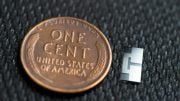
Researchers have used advanced imaging techniques to understand the causes of failure in lithium metal solid-state batteries (Li-SSBs), according to a study published in Nature. Unlike conventional batteries, Li-SSBs replace the flammable liquid electrolyte with a solid one and use lithium metal as the anode. This enables better safety and more energy storage, potentially revolutionizing the electric vehicle (EV) and aviation sectors.
Oxford University researchers have discovered how lithium metal solid-state batteries (Li-SSBs) fail, potentially paving the way for improved EV batteries. The team identified that the formation and growth of ‘dendrites’ cause the batteries to short-circuit, insights that could help address technological hurdles in solid-state battery development.
- A new study has revealed the mechanisms that cause lithium metal solid-state batteries to fail.
- Researchers used a high-resolution imaging method to visualize batteries in unprecedented detail during charging.
- The new insights could help overcome the technical issues with solid-state batteries, unlocking a game-changing technology for electric vehicles and aviation.
Significantly improved electric vehicle (EV) batteries could be a step closer thanks to a new study led by University of Oxford researchers, published on June 7 in Nature. Using advanced imaging techniques revealed mechanisms that cause lithium metal solid-state batteries (Li-SSBs) to fail. If these can be overcome, solid-state batteries using lithium metal anodes could deliver a step-change improvement in EV battery range, safety, and performance, and help advance electrically powered aviation.
One of the co-lead authors of the study Dominic Melvin, a PhD student in the University of Oxford’s Department of Materials, said: “Progressing solid-state batteries with lithium metal anodes is one of the most important challenges facing the advancement of battery technologies. While lithium-ion batteries of today will continue to improve, research into solid-state batteries has the potential to be high-reward and a game-changer technology.”
Li-SSBs are distinct from other batteries because they replace the flammable liquid electrolyte in conventional batteries with a solid electrolyte and use lithium metal as the anode (negative electrode). The use of the solid electrolyte improves the safety, and the use of lithium metal means more energy can be stored. A critical challenge with Li-SSBs, however, is that they are prone to short circuit when charging due to the growth of “dendrites”: filaments of lithium metal that crack through the ceramic electrolyte. As part of the Faraday Institution’s SOLBAT project, researchers from the University of Oxford’s Departments of Materials, Chemistry and Engineering Science, have led a series of in-depth investigations to understand more about how this short-circuiting happens.

X-ray computed tomography images showing the progressive growth of a lithium dendrite crack within a solid-state battery during the charging process. Credit: Dominic Melvin, Nature, 2023.
In this latest study, the group used an advanced imaging technique called X-ray computed tomography at Diamond Light Source to visualize dendrite failure in unprecedented detail during the charging process. The new imaging study revealed that the initiation and propagation of the dendrite cracks are separate processes, driven by distinct underlying mechanisms. Dendrite cracks initiate when lithium accumulates in sub-surface pores. When the pores become full, further charging of the battery increases the pressure, leading to cracking. In contrast, propagation occurs with lithium only partially filling the crack, through a wedge-opening mechanism which drives the crack open from the rear.
This new understanding points the way forward to overcoming the technological challenges of Li-SSBs. Dominic Melvin said: “For instance, while pressure at the lithium anode can be good to avoid gaps developing at the interface with the solid electrolyte on discharge, our results demonstrate that too much pressure can be detrimental, making dendrite propagation and short-circuit on charging more likely.”
Sir Peter Bruce, Wolfson Chair, Professor of Materials at the University of Oxford, Chief Scientist of the Faraday Institution, and corresponding author of the study, said: “The process by which a soft metal such as lithium can penetrate a highly dense hard ceramic electrolyte has proved challenging to understand with many important contributions by excellent scientists around the world. We hope the additional insights we have gained will help the progress of solid-state battery research towards a practical device.”
According to a recent report by the Faraday Institution, SSBs may satisfy 50% of global demand for batteries in consumer electronics, 30% in transportation, and over 10% in aircraft by 2040.
Professor Pam Thomas, CEO, Faraday Institution, said: “SOLBAT researchers continue to develop a mechanistic understanding of solid-state battery failure – one hurdle that needs to be overcome before high-power batteries with commercially relevant performance could be realized for automotive applications. The project is informing strategies that cell manufacturers might use to avoid cell failure for this technology. This application-inspired research is a prime example of the type of scientific advances that the Faraday Institution was set up to drive.”
Reference: “Dendrite initiation and propagation in lithium metal solid-state batteries” by Ziyang Ning, Guanchen Li, Dominic L. R. Melvin, Yang Chen, Junfu Bu, Dominic Spencer-Jolly, Junliang Liu, Bingkun Hu, Xiangwen Gao, Johann Perera, Chen Gong, Shengda D. Pu, Shengming Zhang, Boyang Liu, Gareth O. Hartley, Andrew J. Bodey, Richard I. Todd, Patrick S. Grant, David E. J. Armstrong, T. James Marrow, Charles W. Monroe and Peter G. Bruce, 7 June 2023, Nature.
DOI: 10.1038/s41586-023-05970-4









Tsk, tsk. The anode is the positive, not the negative electrode.